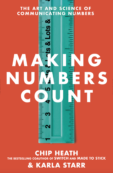How do you make your idea believable? You can get an external authority (the C. Everett Koop of your field) to vouch for it. You can use data and statistics. Or you can find a way to make your idea credible on its face. One technique for doing that is to use what we call a testable credential. A classic testable credential was Ronald Reagan’s line from the 1980 presidential debate: Are you better off now than you were four years ago? Reagan didn’t use statistics, and he didn’t cite influential economists. (It would have been easy to do either.) Instead, he simply let the audience judge for itself: Is my idea credible? Do you believe the economy has worsened?
A great example of a testable credential hit my inbox this week. A graphic designer named John Burns, who created the Ruffles logo (among others), used one against me. And it worked. Here’s what he said:
“As a career-long graphic designer, I love your book cover and website.
I have one suggestion for you, after reading a few of your blog
entries. Unlike the old days of the typewriter, where you would hit the
space bar twice after a sentence, the current typographic practice on
the computer is to hit it only once. In the typewriter days, there was
mono-spacing. Each letter, whether it was an i or a W, or even a .
(period), was given the same amount of space. That lead to uneven
spacing. The only way to make the end of sentences obvious, was to add
two spaces. Current technology, however, has given us proportional
spacing. So, now the type looks better, and the extra space after a
sentence is extraneous.
I’m now going to copy and paste below the above paragraph, to prove my
point. In the top paragraph, I used only one space after a sentence.
Below, I’ve added an additional space. Note how the extra space
actually creates a distractive hole in the text.
As a career-long graphic designer, I love your book cover and website.
I have one suggestion for you, after reading a few of your blog
entries. Unlike the old days of the typewriter, where you would hit
the space bar twice after a sentence, the current typographic practice
on the computer is to hit it only once. In the typewriter days, there
was mono-spacing. Each letter, whether it was an i or a W, or even a .
(period), was given the same amount of space. That lead to uneven
spacing. The only way to make the end of sentences obvious, was to add
two spaces. Current technology, however, has given us proportional
spacing. So, now the type looks better, and the extra space after a
sentence is extraneous.”
I have to admit, after I read the first few sentences, I was skeptical. A little annoyed. But then Burns said, basically, “See for yourself.” And he was right (see for *your*self). He has made me a one-space believer. What an ingenious way to make the case.
As a side note, I am finding it incredibly difficult to break this habit. (Even as I typed up this story, I continually had to backtrack and delete the double-spaces my fingers had imperiously inserted.) Learning to limit myself to one space feels about as natural as learning to end sentences with a comma.



